6 Ways to Protect Your Tomatoes From Birds
Use a few different methods to keep flying pests out of the veggie garden
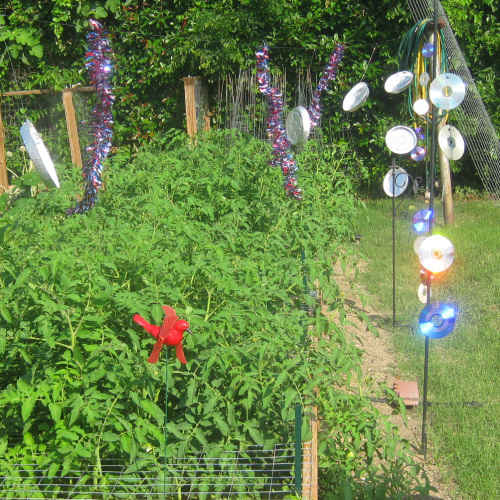
No garden is complete without tomatoes, and those of us who are tomato devotees each year are faced with several pest challenges. From the cutworm who can decapitate young transplants overnight, to the tomato hornworm that will strip a plant bare of its leaves and smaller stems in a couple days or less, to leaf miners and flea beetles known for their own flavor of leaf damage. No damage, however, compares to the ruthless assaults on tomatoes than Texas’ state bird, the mockingbird.
Here in North Texas, the bird is pretty much a mainstay among all the flying creatures; its singing and yammering can be heard on a daily basis. For many years, I protected my tomato plants with a series of “cubes,” or square box cages that were basically wood frames covered with metal chicken wire. While this method offered near-perfect protection from the mockingbirds, it made accessing, maintaining, and harvesting from the tomato plants cumbersome at best.
Since the cube cages ran their course of use and were falling apart, I knew I had to do something different this year. I had talked to several people who hadn’t had any problems with the mockingbirds, to find out what they were (or weren’t) doing. The consensus seemed to be to have something that was distracting or frightening to them.
You could certainly just cover the tomatoes with bird netting or a similar material, but I wanted to try something different. The following is how I have set up my “tomato defense system” which will hopefully help you keep the birds away from your tomatoes, too.
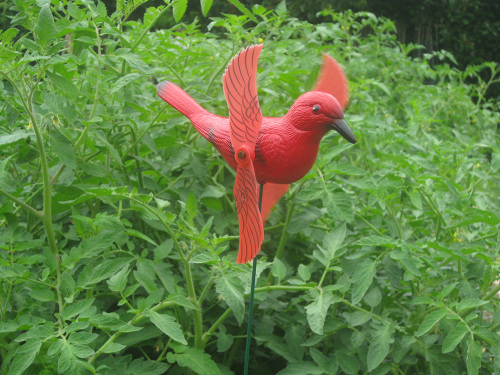
STEP 1 – Give them what they want.
What! Are you serious? Yep. Although it’s not really a deterrent, I have placed a birdbath at the opposite end of the garden. Why? Well, why were the birds punching large holes into my beautiful tomatoes? Water. They were probably thirsty and knew that the inside of the fruit has a fair amount of liquid inside it. They were after the water, so why not give them what they need? I figured that if they discovered that they had an easy water source to get to, they may not be as desperate—especially during the brutal dry summers we get here.
STEP 2 – Build the foundation.
I took advantage of a metal T-shaped post already in the yard that was put in to attach clothes lines to. I removed the clothes lines after I moved in, so the post has just sat there unused—until now. Since the post was on one side of my tomato bed, all I had to do was put in a metal fence post on the opposite side. I connected the two posts with 50-pound-test clear monofilament fishing line.
|
|
STEP 3 – Keep it moving.
This involved setting up three types of moving objects. The first was a “wind spinner,” a type of stationery kite that was supported by a pole. The wind spins its parts while moving the whole device around. The stronger the wind blew, the more it spun. Two of those are set up. They are patriotic-colored, with bright reds and blues. The second type of moving object was something suspended from a line, free to move around in any direction. Enter old CDs, DVDs, and aluminum pie pans. I needed something inexpensive or something I already had at home, and these fit the bill perfectly. The third, foil-colored garland provided a “flying snake” effect, as they were attached to the main line.
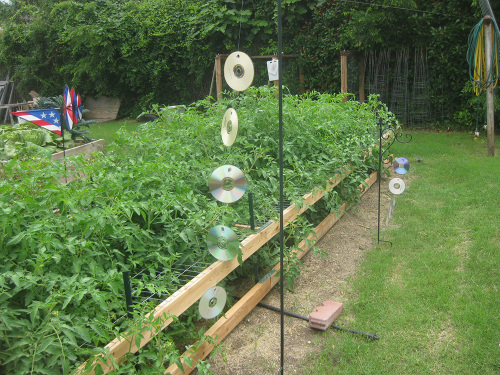
STEP 4 – Brighten up the sky.
My research also revealed that mockingbirds (and other types of birds) could be frightened or distracted by bright objects that reflected light in all directions. The CDs, DVDs, and pie pans not only serve as moving objects; they are great at reflecting the sun’s light as they move. Since the garland is made of a metal foil material, they also sparkle in the sunlight.
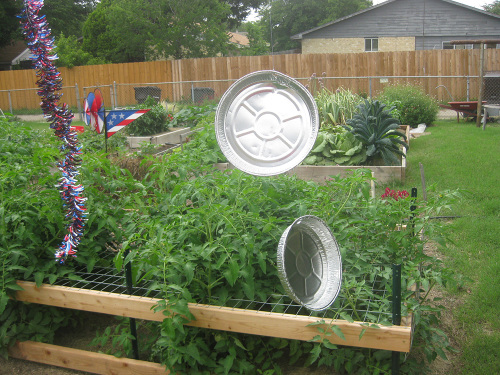
STEP 5 – Sound off.
If you have a cloudy day, you take away the reflective light advantage of the setup. However, you still have the moving objects. You also have a third dimension created by the pie pans—sound. As the pans get pushed around by the wind, they make banging noises (not enough to be annoying, fortunately).
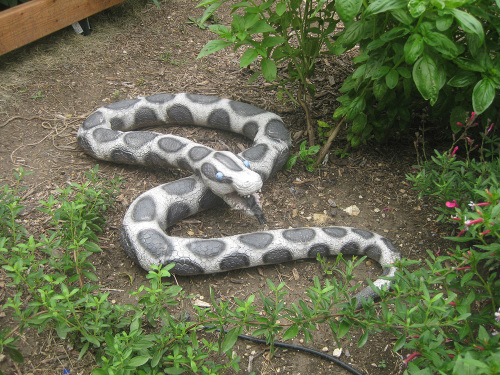
STEP 6 – Rubber reptiles.
Though my dog is my true garden buddy, I have another “assistant.” This assistant is a 4-foot-long rubber snake. Its name is Egor, and it was purchased at a Halloween store last year. Every time I’m out in the garden for longer than a few minutes, I move Egor to a new location. This may not really be distracting to the birds, but I make the effort anyway.
The proof of this system working will be in the proverbial pudding. I will be convinced that it helped if nothing happens. In other words, none (or very few) of my beautiful tomatoes will have been damaged. And I’ll have a great answer to anyone thinking I’ve “flipped my wig” as a crazy gardener.
I’ve also posted a short video here showing the setup in action.








Comments
Log in or create an account to post a comment.
Sign up Log in